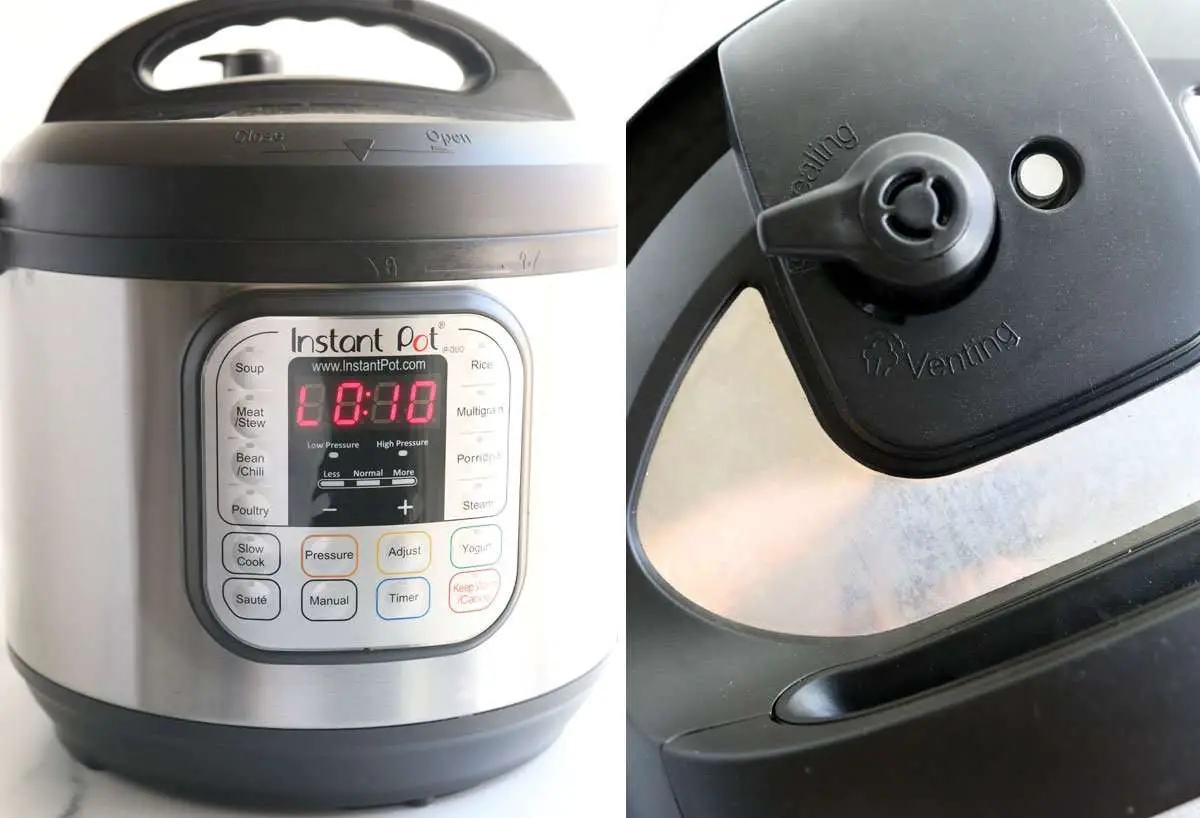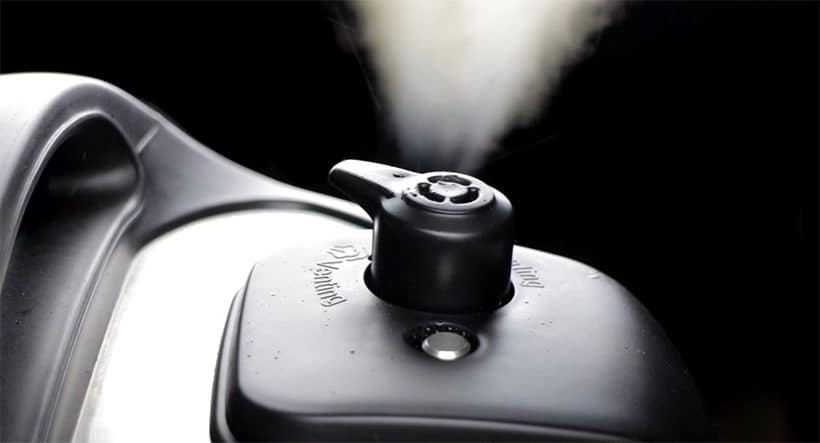Q: What Is A Natural Pressure Release
A natural;pressure release is when you leave the pressure release switch in the Sealed position when the cook time ends. This lets the pressure release slowly, without you doing anything.;When the pressure is fully released, the float valve will drop and the lid will unlock and;open.
A natural pressure release is a bit anticlimactic in comparison to a quick pressure release. There is no jet of steam when the natural pressure release starts. Theres also no clear way to tell when the pressure is fully released, and no beep or signal when the lid unlocks. Sometimes you can hear the float valve drop if youre close by.
The time it takes for the pressure to release naturally will vary depending on the ingredients and amount of liquid in the pressure cooker.;A natural pressure release can;take from 5;to 30 minutes in the electric pressure cooker.
Food inside the cooking pot will continue to cook as the pressure decreases.
Q: What Is An Abbreviated Natural Pressure Release
The different types of pressure releases can also be combined. You dont have to wait for all the pressure to release to get the benefit of a natural pressure release.
In many of my recipes, I will let the pressure release naturally for a certain number of minutes, then I will finish with a quick pressure release.
I almost always only wait 10 minutes before I release the remaining pressure. Combining the two release options reduces waiting time yet gives you many of the benefits of a natural pressure release, such as reducing foam and tenderizing meats.
How To Do A Quick Release In Bursts
A quick release in bursts can take up to 5 minutes. You can keep the Keep Warm mode on or off while doing a quick release in bursts. If you wish to turn this mode off, press Cancel.
Also Check: Can Crock Pot Liners Be Used In An Instant Pot
What Is The Difference Between A Quick Pressure Release Or Natural Pressure Release And When Do I Use Them
Those are often the first questions new pressure cooker users ask. So I thought it would be a perfect time for a post explaining it for all those who have an electric pressure cooker or multi-cooker like the Instant Pot waiting for them under the tree.
When the cook time ends, your pressure cooker will beep. At this point, the recipe will direct;you to release the pressure in the cooking pot. You can release the pressure two ways: a quick pressure release or a natural pressure release.
I really like the way the Instant Pot summarizes the two pressure releases:
Now for the details:
How To Do A Natural Or Quick Release

The procedure for doing a natural or quick release are easy to remember.
For a natural release of pressure: do nothing. Just wait for the pressure to release. Once its done, the float valve will drop, indicating that its okay to open the lid.
See the image below. On the left the pressure is still high and the float valve is up. On the right, the pressure has completely released and the float valve is down.
For a quick pressure release: once the machine beeps to indicate the cooking time is done, carefully turn the valve from sealing to venting.
On some machines, this is a switch instead of a valve, which you turn from Seal to Vent. Be sure to keep your hands away from the actual vent, which is where the steam will spout from.
Also Check: How To Make Pot Roast In Instant Pot
Steam Vent Is Blocked
When the cooking time that you programmed into the pot finishes, steam will automatically start to naturally vent from the steam value on top of your instant pot. You can, at that point, choose to rapidly vent the steam if you want.
If you cannot naturally release steam into the room that youre in, and the steam release valve will not release steam manually either, then the steam release valve itself may be blocked.
This is a fairly common problem due to the fact that a lot of people use their instant pots to cook fine foods like rice or quinoa the small grains can sometimes get caught in the steam valve, leading to a clog which can impair the overall function of the machine.
How To Use Quick Release
To use quick release on an Instant Pot, the venting knob needs to be turned from “seal” to “vent.” This allows steam to flow out from inside the cooking pot more quickly and release the pressure inside. It might spit a little when the knob is turned, so consider using oven mitts or a dish towel to keep from getting scalded. After a few minutes of venting, the steam will stop and the float valve will drop, allowing for the lid to be opened safely.
Lauren Corona is a writer for BestReviews. BestReviews is a product review company with a singular mission: to help simplify your purchasing decisions and save you time and money.
BestReviews spends thousands of hours researching, analyzing and testing products to recommend the best picks for most consumers. BestReviews and its newspaper partners may earn a commission if you purchase a product through one of our links.
Distributed by Tribune Content Agency, LLC.
You May Like: How Long To Cook 1 Pound Roast In Instant Pot
When To Use Natural Release
Certain recipes need, taste and come out better using Natural Release. But in general, I try to develop Instant Pot recipes with Quick Release. Because time, friends. Time. I need to feed my hungry family asap. Aint nobody got time for NR.
But lets go over recipes when you want to use Natural Release:
What Is A Natural Release On An Instant Pot
What is a Natural Release on an Instant Pot? The Instant Pot is a wonderful pot that makes cleaning out the oven fast and easy. They can be used with either coffee or tea, making it possible to have hot tea or coffee right outside your home, ready to drink in a matter of minutes. But, are they really a natural way to release steam into the pot?
For those of you who have never seen an Instant Pot or tried to explain what it is, Ill do my best to simplify it for you. A Natural Release on an Instant Pot is a special type of cast iron pot that has a spout on the top of it designed to release steam. In theory, this means that when you fill the pot with water and place any type of food or liquid into the pot, the water will begin to release steam into the pot just as if you were pouring hot tea or coffee into the pot.
While this may seem very easy, there are a few things to take into consideration before buying an instant pot of this type. To begin with, is the pot going to be used for hot water only, or will it also be used to release steam into the kitchen while cooking? If it is going to be used for hot water only, you should look for an oil-free pot that will not require you to add extra cooking oils. These pots are especially good for people who have a sensitivity to certain oils. For those who want to add oils to the pot, it may be best to choose a pot that is compatible with your stoves burner mechanism.
Recommended Reading: How To Cook Meat With Instant Pot
Benefits Of Instant Pot
The Instant Pot provides several benefits like saving time and energy. This is due to the inner pot being fully insulated; hence, less energy is needed to heat up.
The usage of less liquid means that the food in the Instant Pot will boil at a faster rate which saves plenty of time. When compared to other cooking appliances, it has been found that the Instant Pot lessens energy use and cooking time up to almost 60%.
Instant Pot assists in the conservation of Vitamins and Nutrients. Vitamins and Nutrients which are soluble in water are drained out of foods during normal cooking methods such as steaming or boiling. However in an Instant Pot, the food is cooked quickly and evenly which makes it more nutritious and healthy.
Additionally, when food is cooked on open containers with or without a lid, the food is open to heat and oxygen which may cause it to have a dull colour and lower flavour.
Meanwhile when steam saturates food in the Instant Pot, it retains the bright colour and so the food looks much better. Instant Pot has an airtight design which makes flavours develop faster resulting in better quality food. Moreover, the use of oil in Instant Pot is less which results in healthier food.
Therefore, Instant Pot can be used to purify water and may act as sterilization equipment. Toxins that occur naturally are harmful and can be removed from food by using Instant pot. It helps to bring down the concentrations of Phytohaemagglutinin and aflatoxins in food to a secure level.
How To Do A 10 15 Minutes Natural Pressure Release
After the cooking cycle finished, wait 10 15 minutes before moving the Venting Knob from Sealing Position to Venting Position to release the remaining pressure.
Always make sure the Floating Valve completely drops before opening the lid.
Whats the advantage?
- Compare to Quick Release:;Significantly reduces the;chance of food splattering out from the Pressure Release Valve.
- Compare to Natural Release:;Faster release method when the pressure cooker is full of food with high liquid volume.
Recommended Reading: How To Make Alfredo Pasta In Instant Pot
Is Quick Release Safe
Yesif you take the right precautions. The steam that immediately releases from the Instant Pot will be extremely hot. The Instant Pot User Manual warns to not place your hand or lean your face over the cooker while it is releasing steam. Its best to turn the valve with an object such as kitchen tongs or a wooden spoon to avoid any skin coming in contact with the hot steam. Other Instant Pot users like wearing silicone oven mitts, or simply covering their hand with a kitchen towel.
Timed Natural Release A Mix Of Quick Release And Natural Release

A Timed Natural Release is a hybrid version of the natural release and quick release methods.
This method is handy when you do not have much time on your hands, but your recipe demands a natural release process. Here, you get the benefit of both steam releasing naturally as well as quickly while the food continues to cook during the waiting period.
Don’t Miss: Can You Cook Bacon In An Instant Pot
What Is Natural Release Instant Pot
As the name suggests, you need to leave your instant pot to work on its own for this method. Your instant pot will release the pressure once it depressurizes on its own.
Your instant pot will signal you with a beep stating that it has completed the cooking cycle and will automatically start releasing the pressure.
To figure out if your instant pot has released its steam completely, completely check the float valve for this. The natural release process is complete if it drops down.
Once the pressure is released it is now safe to open the lid. Remember, you will only be able to open the lid if the pot is depressurized. Never try to open the lid before this process.
Does It Really Matter Which You Use
Yes, it is important to depressurizing your pressure cooker in the right way, according to the food youre cooking. It can make a huge impact on the foods texture and temperature. Just like leaving a steak on the grill too long, your food can become overcooked and dry if you release pressure in the wrong way.
Two of the main concerns are:
- Releasing the pressure too quickly when cooking a pot full of soup or foamy foods. When you do a manual release of a pot full of soup or broth, its possible that the steam will sputter and spray all over your kitchen. It can take quite a while for a pot full of liquid to release pressure, so it can take a good 5 minutes to release it with a manual release. During that time, steam is spraying and heavy aromas are filling your house.
- Overcooking delicate foods. If youre cooking asparagus in the Instant Pot and you allow it to do a natural release of pressure, its likely the asparagus will be complete mush before you take it out. The same applies to any vegetables youre steaming. It also applies to meats that dry out when over cooked, like chicken breast or salmon.
Recommended Reading: How Long Does Chicken Take To Cook In Instant Pot
Turning The Instant Pot Off
There are those who will unplug the pot to allow for the natural release of pressure. Some people will leave the cooker plugged in. At this point, youll notice the display will show L0:00. The L here stands for elapsed time.
If you leave the pot plugged in, it will automatically switch to the Keep Warm mode. But take note that whether the pot is turned on or not, the keep warm setting wont affect the amount of time it will take for the pot to release the pressure naturally.
Its all basically up to you on what you prefer. Personally, Id prefer for the pot to be plugged in so I can see for how long it has already been done.
How Long Does Quick Release Take On Instant Pot
The instant pot quick release time differs greatly depending on what food you are cooking.
If you have a full instant pot with food with a lot of liquid such as our instant pot stew and dumplings, then you can expect to have a wait. But for some steamed vegetables such as our instant pot steamed broccoli, then its just a couple of minutes.
You May Like: How To Cook Chicken Breast In Instant Pot
Why Is The Natural Release On My Instant Pot Not Working
The process of natural release on an instant pot is a fairly simple one pressure builds during the cooking period due to steam forming within the pot. The instant pot is a sealed environment, which means that the steam cannot escape, and pressure builds.
To cut a long story short, the natural release on your instant pot wont be working because a component that causes pressure to be kept within the pot will be broken. This could be several different components within the pot, including the steam release value or the sealing ring which sits inside the lid of your instant pot.
Luckily, there are plenty of ways to fix anything that may be wrong with your instant pot these appliances are designed to last.
How Soon Could You Expect The Instant Pot To Pressurize
The time at which you set the pressure cooker is set off not as same as the time that you set. Initially, the pressure builds up and the timer is set off after that. Before an instant pot pressurizes, you need to preheat it.
To sum it up, the time you set is not the time it will take for the food to cook.
The instant pot takes around 10 minutes to create pressure; the exact time depends on the quantity and temperature of the food. If you add cold water to the instant pot rather than hot, it would take around 20- 30 minutes for it to heat up.
After the pressure-cooking cycle completes, you can now commence the natural pressure release which could take anywhere between 5-30 minutes which depends on the quantity of water in the pot.
In this brief guide, we answered the question, How long does it take for an instant pot to natural release?. We discussed the steps to make an instant pot natural release. We studied the basic aspects and functions of the instant pot.
Read Also: How Long To Cook Pre Cooked Ribs In Instant Pot
How Natural Release Works And When To Use It
Natural release works exactly the way it sounds. Using this method, theres really nothing you have to depressurize your pressure cooker. Once active cooking is finished, the pressure will automatically slowly drop inside the electric pressure cooker. Because of this slow drop in pressure and heat, when using natural release, food continues cooking even though active cooking is complete.
Use this method when cooking meat, foods that increase in volume or foam , soups, or any other foods that are primarily liquid.
Timing for natural release varies, and will differ based on the model of pressure cooker you use, the type of food, and the level of fill. Overall it can take between 10 and 30 minutes.
My Recipe Says To Do A Natural Release Followed By A Quick Release Help

Not to worry, many recipes have you do this.
First, you perform an Instant pot Natural Release for a certain amount of time, usually 10 or 15 minutes.
Then you to a Quick Pressure Release to toggle the steam release valve to quickly vent any remaining pressure.
Finally, you release any remaining pressure by moving the top of the Instant Pot from the sealed position to completely open. Just be careful to do this slowly.
You May Like: How To Cook Pinto Beans In An Instant Pot
